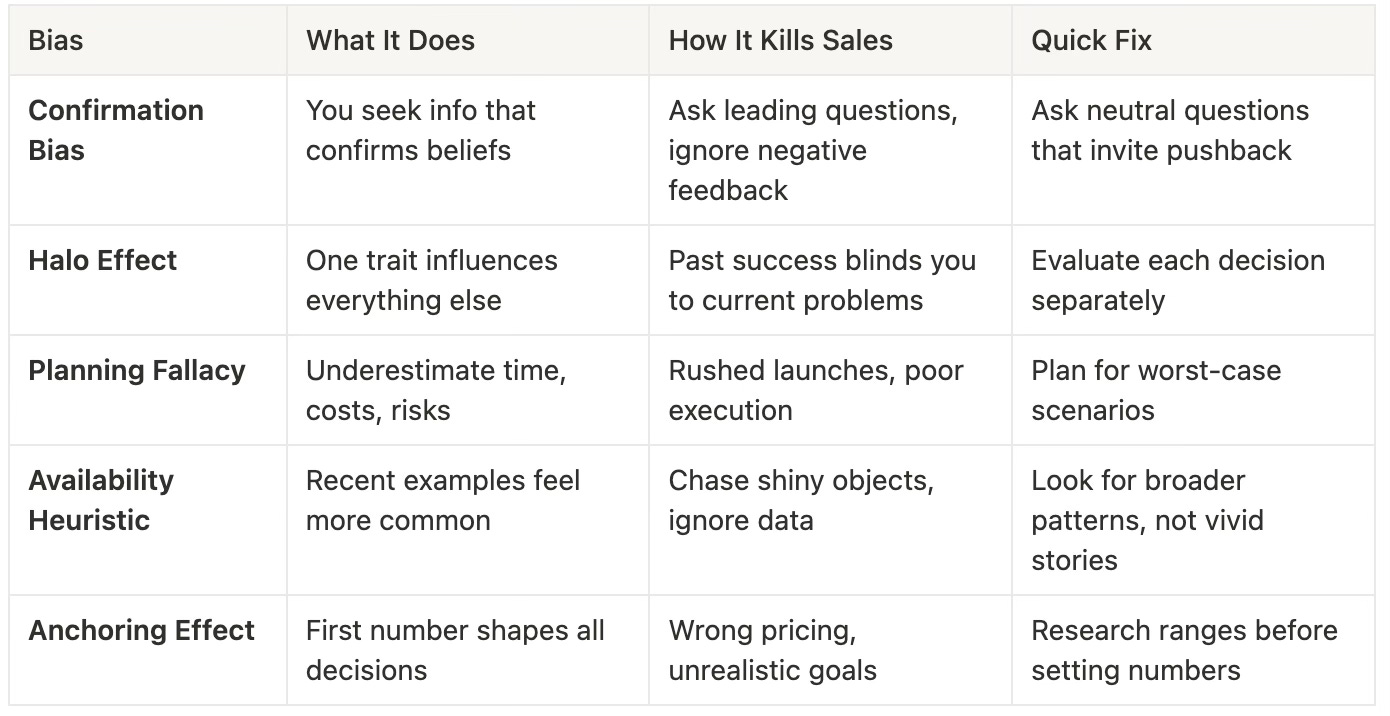You spend months building your course. Launch day arrives. You sell 3 copies.
You price your coaching program. Second-guess yourself for weeks. Change it 4 times.
You ask your audience what they want. Get generic answers that lead nowhere.
The pattern repeats. Product after product. Launch after launch.
Here's what nobody tells you: 95% of new products fail, and 92% of startups fold in their first three years. The problem isn't your skills or your market. It's your brain.
Your mind relies on simplified information processing strategies called heuristics, which create systematic, predictable errors called cognitive biases. These biases feel like intuition but they're shortcuts that sabotage your decisions.
This newsletter reveals 5 specific biases killing your digital product sales, backed by psychology research. You'll get practical fixes and simple prompts to stop your brain from working against you.
The Psychology Behind Product Failure
The study of cognitive biases has practical implications for areas including entrepreneurship, finance, and management. These biases cloud judgment, distort perceptions, and prevent exploration of alternative viewpoints.
Your brain has two systems:
System 1 (Autopilot): Fast, automatic, energy-saving. Relies on shortcuts and gut feelings.
System 2 (Pilot): Slow, deliberate, energy-draining. Requires conscious effort to activate.
Most business decisions happen on autopilot. You default to what feels right instead of what works.
5 Biases Destroying Your Sales
1. Confirmation Bias: The Echo Chamber Trap
The psychology: You actively seek information confirming your beliefs while ignoring contradictory evidence.
How it shows up:
Asking "Would you buy my course?" instead of "What's your biggest challenge?"
Surveying only engaged followers, not people who didn't buy
Googling success stories, not failure analyses
The damage: You build products based on hope, not reality.
Your fix: Ask questions that challenge your assumptions.
Prompt:
I believe [your assumption about product/market].
What perspectives, risks, or counterarguments should I consider that I might be overlooking? What would someone who disagrees say?
2. Halo Effect: When Success Becomes Your Enemy
The psychology: One strong impression influences how you judge everything else.
How it shows up:
First product succeeds, so you assume everything will
Competitor has nice design, so you copy their entire strategy
One great testimonial makes you think everyone loves your product
The damage: You stop validating each decision independently.
Your fix: Judge each situation on its own merits.
Prompt:
I think [your belief based on one experience].
What might my initial impression be making me overlook? What should I examine more objectively? What are the specific pros and cons here?
3. Planning Fallacy: Why Your Timeline Is Always Wrong
The psychology: You consistently underestimate time, costs, and risks while overestimating benefits.
How it shows up:
"I'll create this course in 4 weeks" (takes 3 months)
"Launch budget: $500" (spend $2,000)
"I'll get 100 sales first week" (get 12)
The damage: Rushed execution, disappointed customers, burned-out you.
Your fix: Plan for reality, not best-case scenarios.
Prompt:
I'm planning [your project] in [timeline] with [budget/resources].
Assume I'm falling for planning fallacy. What realistic steps, time estimates, and common pitfalls should I expect? Where do solopreneurs get stuck with similar projects?
4. Availability Heuristic: The Viral Story Trap
The psychology: You judge likelihood based on how easily examples come to mind, not actual frequency.
How it shows up:
See one viral TikTok, assume that's the best marketing channel
One customer complains about price, think all prices are too high
Read about $100K launch, assume that's normal
The damage: You chase outliers instead of proven strategies.
Your fix: Look for data patterns, not memorable stories.
Prompt:
I'm thinking about [strategy] because [recent example you saw].
What broader data, trends, or comparisons should I consider beyond what I've recently experienced? What does the typical result look like?
5. Anchoring Effect: The First Number Problem
The psychology: You rely too heavily on the first piece of information, especially numbers.
How it shows up:
See competitor at $497, price yours at $399 without research
First month makes $1,000, assume that's your baseline
Someone mentions 5% email conversion, think yours should match
The damage: Wrong pricing, unrealistic expectations, poor positioning.
Your fix: Research ranges before making number decisions.
Prompt:
I'm using [specific number/benchmark] to guide [your decision].
What range, context, or comparison should I consider to make an objective decision without letting this anchor my thinking?
The 5-Question Bias Buster
Before any major decision, ask:
What am I assuming? Name your assumptions explicitly
Who disagrees? Seek opposing viewpoints
What would I tell a friend? Remove emotional attachment
What does data show? Look beyond personal experience
What's worst-case? Plan for obstacles, not just success
Turn AI Into Your Thinking Partner
Add this instruction to any AI conversation:
Act as my thinking partner, not my cheerleader.
When I share ideas or decisions, challenge my assumptions. Point out what I might miss. Ask hard questions I'm avoiding.
If I'm too optimistic, ground me in reality. If I'm narrow-focused, expand my view. If emotion drives me, show me data.
I need better thinking, not validation. Help me see blind spots.
Your 48-Hour Challenge
Pick one bias from this list. The one that made you think "I do that."
For the next 48 hours, before any business decision, ask: "How might this bias affect my judgment?"
Use the matching prompt. Compare your first instinct to the AI response.
Track the difference. You'll be shocked how often your "gut feeling" leads you astray.
Your business doesn't need perfect decisions. It needs better ones. Better decisions start with recognizing when your brain works against you instead of for you.




Very informative post with actionable advice, great read, will definitely be applying some of this to my own process 💯